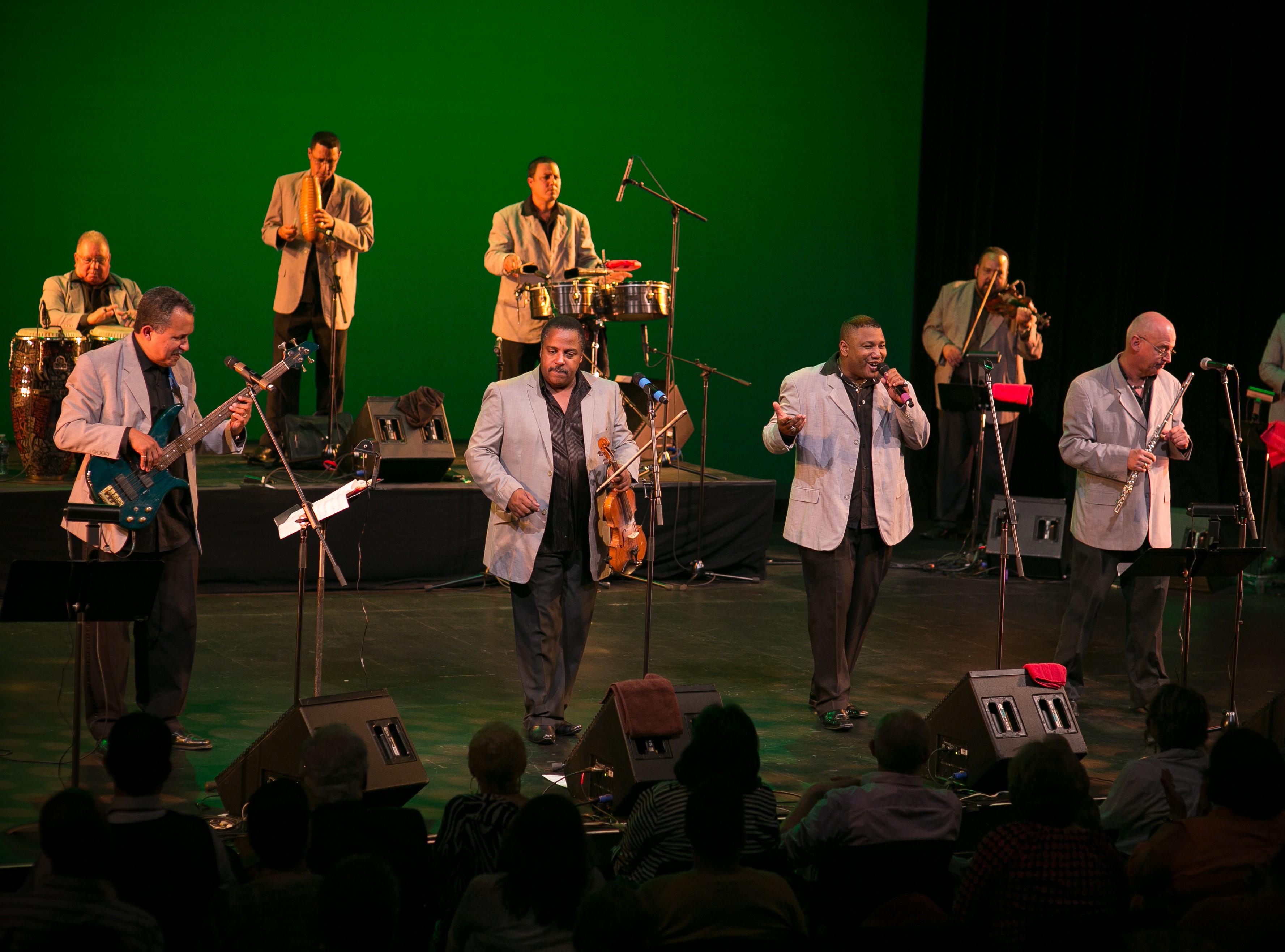Blog April 15, 2014
Concert Review: Legendary Cuban Charanga Orquesta Aragón Live at Schimmel Center
All photographs by Oresti Tsonopoulos. For more of Oresti's photos from the concert, please click here.
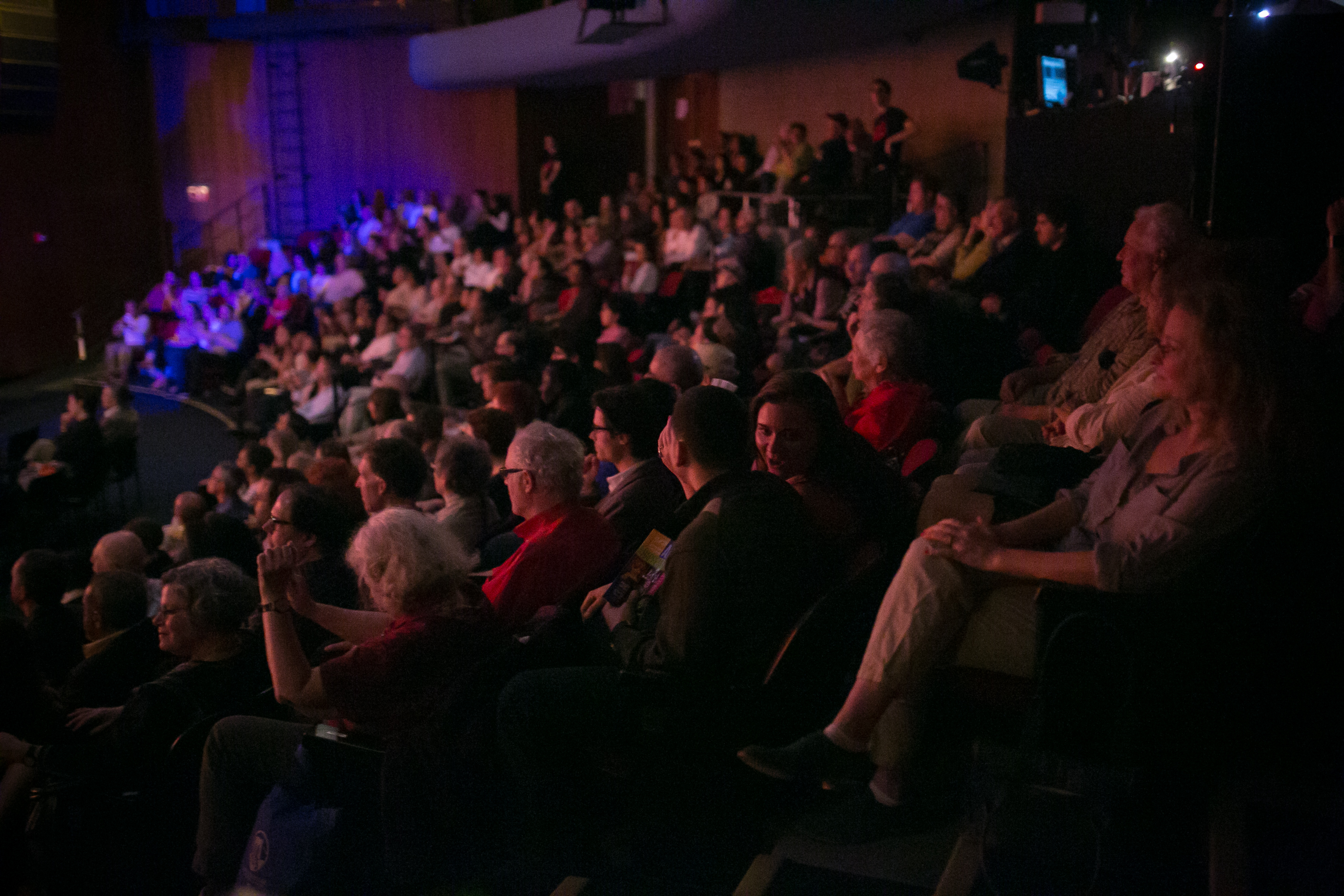 Every seat was filled at the Michael Schimmel Center For the Arts at Pace University. Chatter turned to applause as the band took the stage: Ten middle-aged Cuban men in baggy grey suit jackets, emanating poise and an easy, avuncular charm. The bass-player, Roberto Espinosa Rodríguez, introduced the group in both English and Español, telling the crowd that the 2014 US tour celebrated the 75th year "of the Orquesta, but not of us!" The legendary Orquesta Aragón was founded in 1939 by bassist Orestes Aragón Cantero in Camagüey, Cuba as a semi-classical danzón band which performed for upper-class parties. Through the following 7 decades, Orquesta Aragón pioneered many musical styles, especially cha-cha, son/charanga hybrids, and pachanga. Of course, they also went through many personnel changes, at one time boasting such talents as master-flautist Richard Egües and singer/arranger Rafael Lay Bravo, whose son Rafael Felipe Lay Bravo currently directs the band. As with many legacy bands, the current line-up is pretty hard to find (when the internet did not yield the information, I had to contact their tour manager), as if the individual musicians matter less than maintaining the musical tradition of the Orquesta. (Last year, we experienced a similar thing when we saw the legacy band of Cuban son pioneers Septeto Nacional Ignacio Piñeiro perform in NYC at Aaron Davis Hall.)
But when the band hit, it certainly felt and sounded like classic Aragón! The sweet charanga music floated out from the stage, as if from the parlor-party of a genteel pre-Revolutionary plantation-owner in the Cuban southeast. The three violinists (Lázaro Dagoberto González Sibore and Eric Labaut Lay in the back, Rafael Lay Bravo up front) playing subtle harmonized figures, the soaring flute of master Eduardo Rubio, the smooth piano montunos, the delicate percussion rhythms of timbal, guiro and tumbadoras (known, somewhat incorrectly as 'congas' in many parts of the world, but that's another story for another time and place), all supported the two sugar-voiced vocalists (Lay Bravo and lead singer Juan Carlos Villegas Alfonso) singing in unison up front.
An ancient man sitting nearby called out, "Cachita!" and it didn't take long for the Orquesta to fulfill his wish, playing a note-perfect rendition of their hit cha-cha version of "Cachita" from yesteryear. The man clapped along in glee, although, unfortunately, not in time with the music. "Cachita" was originally composed by famed Afro-Puerto Rican composer Rafael Hernández (words by Bernardo C. Sancristóbal), though Cuban bands such as the Lecuona Cuban Boys had been playing it for decades before Aragón gave it a new, cha-cha twist.
Puerto Rico (via NYC) got a major shout-out when the band played "Isla Del Encanto" from NYC-based charanga band Orquesta Broadway, who, drawing on Aragón as inspiration, helped launch the NYC charanga boom in the 1970s. On Sunday night, Aragón invited up Eddie Zervigon (who is actually Cuban), the star flautist from Orquesta Broadway, and he took the night to new heights with his altisimo-register, dog-whistle-like rhythmic flute attacks.
[caption id="attachment_17974" align="aligncenter" width="617"]
Every seat was filled at the Michael Schimmel Center For the Arts at Pace University. Chatter turned to applause as the band took the stage: Ten middle-aged Cuban men in baggy grey suit jackets, emanating poise and an easy, avuncular charm. The bass-player, Roberto Espinosa Rodríguez, introduced the group in both English and Español, telling the crowd that the 2014 US tour celebrated the 75th year "of the Orquesta, but not of us!" The legendary Orquesta Aragón was founded in 1939 by bassist Orestes Aragón Cantero in Camagüey, Cuba as a semi-classical danzón band which performed for upper-class parties. Through the following 7 decades, Orquesta Aragón pioneered many musical styles, especially cha-cha, son/charanga hybrids, and pachanga. Of course, they also went through many personnel changes, at one time boasting such talents as master-flautist Richard Egües and singer/arranger Rafael Lay Bravo, whose son Rafael Felipe Lay Bravo currently directs the band. As with many legacy bands, the current line-up is pretty hard to find (when the internet did not yield the information, I had to contact their tour manager), as if the individual musicians matter less than maintaining the musical tradition of the Orquesta. (Last year, we experienced a similar thing when we saw the legacy band of Cuban son pioneers Septeto Nacional Ignacio Piñeiro perform in NYC at Aaron Davis Hall.)
But when the band hit, it certainly felt and sounded like classic Aragón! The sweet charanga music floated out from the stage, as if from the parlor-party of a genteel pre-Revolutionary plantation-owner in the Cuban southeast. The three violinists (Lázaro Dagoberto González Sibore and Eric Labaut Lay in the back, Rafael Lay Bravo up front) playing subtle harmonized figures, the soaring flute of master Eduardo Rubio, the smooth piano montunos, the delicate percussion rhythms of timbal, guiro and tumbadoras (known, somewhat incorrectly as 'congas' in many parts of the world, but that's another story for another time and place), all supported the two sugar-voiced vocalists (Lay Bravo and lead singer Juan Carlos Villegas Alfonso) singing in unison up front.
An ancient man sitting nearby called out, "Cachita!" and it didn't take long for the Orquesta to fulfill his wish, playing a note-perfect rendition of their hit cha-cha version of "Cachita" from yesteryear. The man clapped along in glee, although, unfortunately, not in time with the music. "Cachita" was originally composed by famed Afro-Puerto Rican composer Rafael Hernández (words by Bernardo C. Sancristóbal), though Cuban bands such as the Lecuona Cuban Boys had been playing it for decades before Aragón gave it a new, cha-cha twist.
Puerto Rico (via NYC) got a major shout-out when the band played "Isla Del Encanto" from NYC-based charanga band Orquesta Broadway, who, drawing on Aragón as inspiration, helped launch the NYC charanga boom in the 1970s. On Sunday night, Aragón invited up Eddie Zervigon (who is actually Cuban), the star flautist from Orquesta Broadway, and he took the night to new heights with his altisimo-register, dog-whistle-like rhythmic flute attacks.
[caption id="attachment_17974" align="aligncenter" width="617"]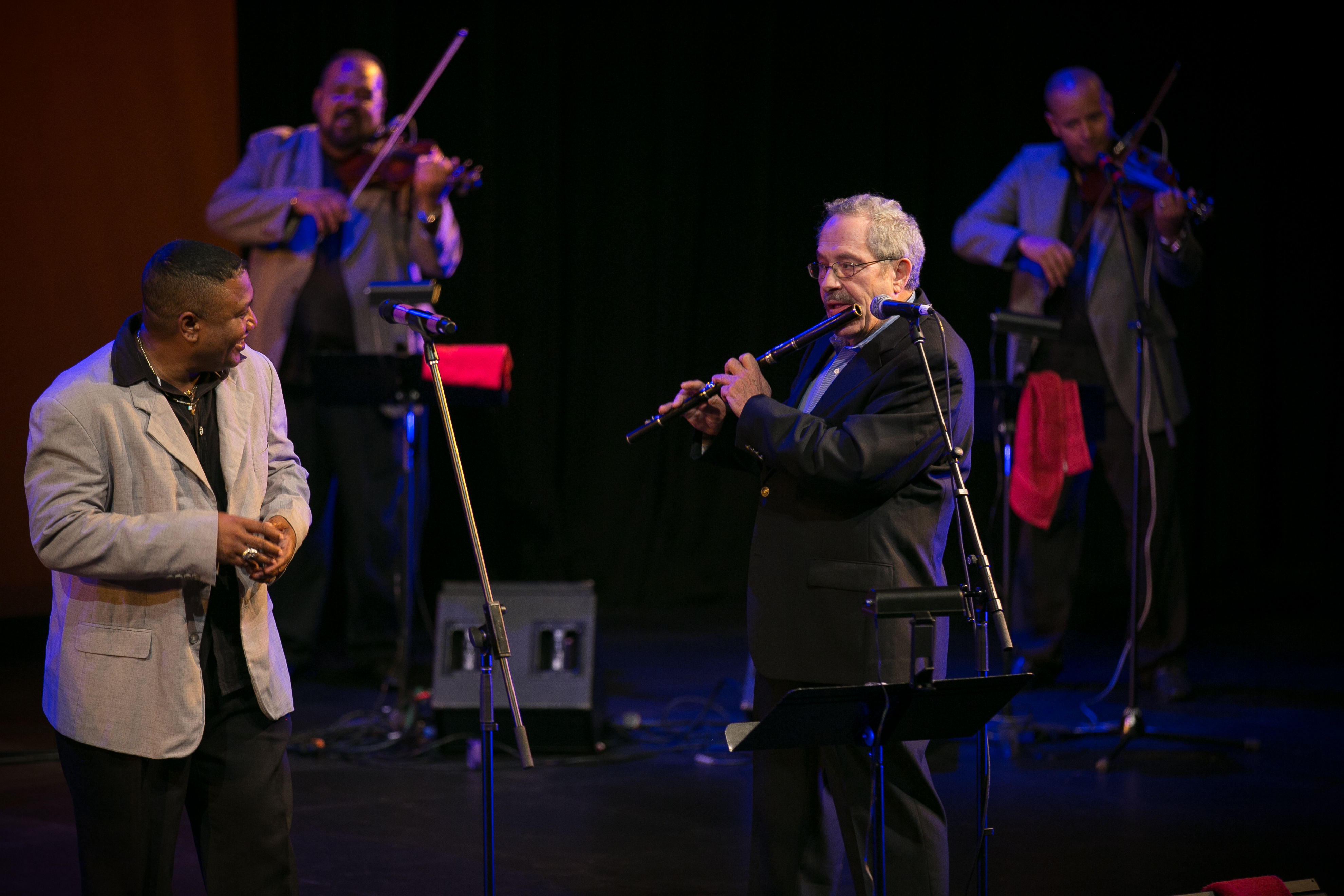 Eddie Verzigon[/caption]
As the band cruised through their classic numbers, including "El Bodeguero", "Pare Cochero" and "Sabrosona", I was struck by their fidelity to the rhythmic quirks of a genre developed before metronomes were the norm: When the band played standard rhythmic figures such as the unison three eighth-note hit (think "cha-cha-cha"), they pulled back on the tempo just slightly; likewise, whenever the singers or violins played a pickup to lead the band in, it was almost always slightly slower than the tempo the band picked up on. These stylistic details really give charanga music a distinctive feel that differs from son or salsa, and it was a pleasure to hear a band execute them with intention and natural swing. And the audience responded joyfully, spilling out into the aisles and dancing in front of the stage, despite the frowning attendants. There was even one hidden maraca player somewhere in the crowd, fulfilling one of the audience requirements for live musica bailable.
As they dug into their dance mode, Aragón played their version of the Senegalese salsa hit "Yaye Boy" which has been performed by everyone from Youssou N'dor with his first band Etoile De Dakar and, of course, Africando; and the centuries-old trans-Atlantic music routes/roots (WestAfrica-Caribbean-NYC) made themselves audible and danceable. The timbalero, Horacio Rodríguez del Toro, seized the moment to inflect the feel with a tiny bit of timba energy, playing across his cowbells and playing quick riffs and fills across the drums. At one point, a big man in a black shirt with cornrows came out of the wings without being announced, picked up a bongo bell, and held it down while the timbalero stretched the limits of meter with a dexterous, energetic solo. After the solo, the mysterious rhythmic assistant slipped away just as he had arrived.
Eddie Verzigon[/caption]
As the band cruised through their classic numbers, including "El Bodeguero", "Pare Cochero" and "Sabrosona", I was struck by their fidelity to the rhythmic quirks of a genre developed before metronomes were the norm: When the band played standard rhythmic figures such as the unison three eighth-note hit (think "cha-cha-cha"), they pulled back on the tempo just slightly; likewise, whenever the singers or violins played a pickup to lead the band in, it was almost always slightly slower than the tempo the band picked up on. These stylistic details really give charanga music a distinctive feel that differs from son or salsa, and it was a pleasure to hear a band execute them with intention and natural swing. And the audience responded joyfully, spilling out into the aisles and dancing in front of the stage, despite the frowning attendants. There was even one hidden maraca player somewhere in the crowd, fulfilling one of the audience requirements for live musica bailable.
As they dug into their dance mode, Aragón played their version of the Senegalese salsa hit "Yaye Boy" which has been performed by everyone from Youssou N'dor with his first band Etoile De Dakar and, of course, Africando; and the centuries-old trans-Atlantic music routes/roots (WestAfrica-Caribbean-NYC) made themselves audible and danceable. The timbalero, Horacio Rodríguez del Toro, seized the moment to inflect the feel with a tiny bit of timba energy, playing across his cowbells and playing quick riffs and fills across the drums. At one point, a big man in a black shirt with cornrows came out of the wings without being announced, picked up a bongo bell, and held it down while the timbalero stretched the limits of meter with a dexterous, energetic solo. After the solo, the mysterious rhythmic assistant slipped away just as he had arrived.
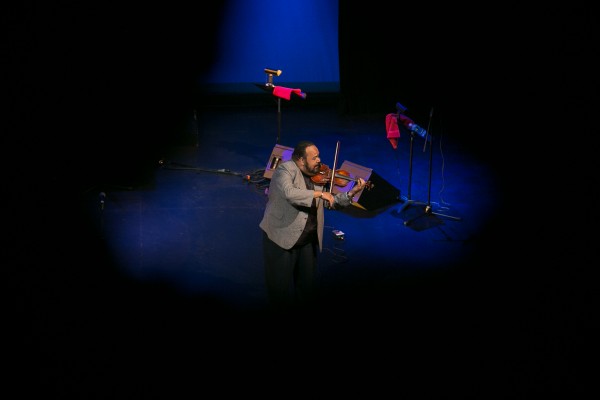 After a short set break, one of the back-up violinists, Lázaro Dagoberto González Sibore, took center stage to solo on the classic tune "Besame Mucho." He played with deep classical virtuosity, using the full range of musical and emotional tactics to bring the audience to its feet, showering him in applause. The piano player, Orlando Jesús Pérez Montero, also stood out as a truly virtuosic soloist, constantly varying techniques and playing with exciting triplet cross-rhythms, while keeping consistency with the old-school style. The night ended as it had begun, with Orquesta Aragón's theme song, and there was something pleasantly formal about the way they only played one song for an encore, and only after the audience truly begged.
After a short set break, one of the back-up violinists, Lázaro Dagoberto González Sibore, took center stage to solo on the classic tune "Besame Mucho." He played with deep classical virtuosity, using the full range of musical and emotional tactics to bring the audience to its feet, showering him in applause. The piano player, Orlando Jesús Pérez Montero, also stood out as a truly virtuosic soloist, constantly varying techniques and playing with exciting triplet cross-rhythms, while keeping consistency with the old-school style. The night ended as it had begun, with Orquesta Aragón's theme song, and there was something pleasantly formal about the way they only played one song for an encore, and only after the audience truly begged.
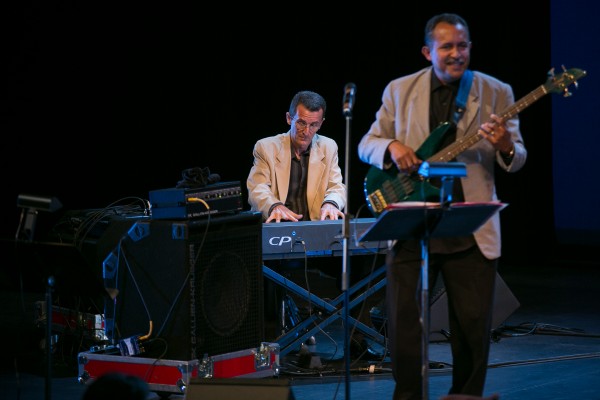 Outside, I asked the timbalero Horacio what the scene for this music is in Cuba. "We play in the hotels. In Varadero and Havana." As I suspected, the legacy is supported by the State, by tourism, and by international touring. For most younger Cubans, Cuban dance music no longer means son or charanga, but rather timba (bands like Los Van Van and Ritmo Oriental evolved the charanga sound in the 1970s, until a group with the name La Charanga Habanera can sound like this. And that track was from nearly 20 years ago) or, more likely, reggaeton. However, it seems there will always be a place for classic charanga in New York. In which case, ¡que sigue La Orquesta Aragón!
Outside, I asked the timbalero Horacio what the scene for this music is in Cuba. "We play in the hotels. In Varadero and Havana." As I suspected, the legacy is supported by the State, by tourism, and by international touring. For most younger Cubans, Cuban dance music no longer means son or charanga, but rather timba (bands like Los Van Van and Ritmo Oriental evolved the charanga sound in the 1970s, until a group with the name La Charanga Habanera can sound like this. And that track was from nearly 20 years ago) or, more likely, reggaeton. However, it seems there will always be a place for classic charanga in New York. In which case, ¡que sigue La Orquesta Aragón!
 Every seat was filled at the Michael Schimmel Center For the Arts at Pace University. Chatter turned to applause as the band took the stage: Ten middle-aged Cuban men in baggy grey suit jackets, emanating poise and an easy, avuncular charm. The bass-player, Roberto Espinosa Rodríguez, introduced the group in both English and Español, telling the crowd that the 2014 US tour celebrated the 75th year "of the Orquesta, but not of us!" The legendary Orquesta Aragón was founded in 1939 by bassist Orestes Aragón Cantero in Camagüey, Cuba as a semi-classical danzón band which performed for upper-class parties. Through the following 7 decades, Orquesta Aragón pioneered many musical styles, especially cha-cha, son/charanga hybrids, and pachanga. Of course, they also went through many personnel changes, at one time boasting such talents as master-flautist Richard Egües and singer/arranger Rafael Lay Bravo, whose son Rafael Felipe Lay Bravo currently directs the band. As with many legacy bands, the current line-up is pretty hard to find (when the internet did not yield the information, I had to contact their tour manager), as if the individual musicians matter less than maintaining the musical tradition of the Orquesta. (Last year, we experienced a similar thing when we saw the legacy band of Cuban son pioneers Septeto Nacional Ignacio Piñeiro perform in NYC at Aaron Davis Hall.)
But when the band hit, it certainly felt and sounded like classic Aragón! The sweet charanga music floated out from the stage, as if from the parlor-party of a genteel pre-Revolutionary plantation-owner in the Cuban southeast. The three violinists (Lázaro Dagoberto González Sibore and Eric Labaut Lay in the back, Rafael Lay Bravo up front) playing subtle harmonized figures, the soaring flute of master Eduardo Rubio, the smooth piano montunos, the delicate percussion rhythms of timbal, guiro and tumbadoras (known, somewhat incorrectly as 'congas' in many parts of the world, but that's another story for another time and place), all supported the two sugar-voiced vocalists (Lay Bravo and lead singer Juan Carlos Villegas Alfonso) singing in unison up front.
An ancient man sitting nearby called out, "Cachita!" and it didn't take long for the Orquesta to fulfill his wish, playing a note-perfect rendition of their hit cha-cha version of "Cachita" from yesteryear. The man clapped along in glee, although, unfortunately, not in time with the music. "Cachita" was originally composed by famed Afro-Puerto Rican composer Rafael Hernández (words by Bernardo C. Sancristóbal), though Cuban bands such as the Lecuona Cuban Boys had been playing it for decades before Aragón gave it a new, cha-cha twist.
Puerto Rico (via NYC) got a major shout-out when the band played "Isla Del Encanto" from NYC-based charanga band Orquesta Broadway, who, drawing on Aragón as inspiration, helped launch the NYC charanga boom in the 1970s. On Sunday night, Aragón invited up Eddie Zervigon (who is actually Cuban), the star flautist from Orquesta Broadway, and he took the night to new heights with his altisimo-register, dog-whistle-like rhythmic flute attacks.
[caption id="attachment_17974" align="aligncenter" width="617"]
Every seat was filled at the Michael Schimmel Center For the Arts at Pace University. Chatter turned to applause as the band took the stage: Ten middle-aged Cuban men in baggy grey suit jackets, emanating poise and an easy, avuncular charm. The bass-player, Roberto Espinosa Rodríguez, introduced the group in both English and Español, telling the crowd that the 2014 US tour celebrated the 75th year "of the Orquesta, but not of us!" The legendary Orquesta Aragón was founded in 1939 by bassist Orestes Aragón Cantero in Camagüey, Cuba as a semi-classical danzón band which performed for upper-class parties. Through the following 7 decades, Orquesta Aragón pioneered many musical styles, especially cha-cha, son/charanga hybrids, and pachanga. Of course, they also went through many personnel changes, at one time boasting such talents as master-flautist Richard Egües and singer/arranger Rafael Lay Bravo, whose son Rafael Felipe Lay Bravo currently directs the band. As with many legacy bands, the current line-up is pretty hard to find (when the internet did not yield the information, I had to contact their tour manager), as if the individual musicians matter less than maintaining the musical tradition of the Orquesta. (Last year, we experienced a similar thing when we saw the legacy band of Cuban son pioneers Septeto Nacional Ignacio Piñeiro perform in NYC at Aaron Davis Hall.)
But when the band hit, it certainly felt and sounded like classic Aragón! The sweet charanga music floated out from the stage, as if from the parlor-party of a genteel pre-Revolutionary plantation-owner in the Cuban southeast. The three violinists (Lázaro Dagoberto González Sibore and Eric Labaut Lay in the back, Rafael Lay Bravo up front) playing subtle harmonized figures, the soaring flute of master Eduardo Rubio, the smooth piano montunos, the delicate percussion rhythms of timbal, guiro and tumbadoras (known, somewhat incorrectly as 'congas' in many parts of the world, but that's another story for another time and place), all supported the two sugar-voiced vocalists (Lay Bravo and lead singer Juan Carlos Villegas Alfonso) singing in unison up front.
An ancient man sitting nearby called out, "Cachita!" and it didn't take long for the Orquesta to fulfill his wish, playing a note-perfect rendition of their hit cha-cha version of "Cachita" from yesteryear. The man clapped along in glee, although, unfortunately, not in time with the music. "Cachita" was originally composed by famed Afro-Puerto Rican composer Rafael Hernández (words by Bernardo C. Sancristóbal), though Cuban bands such as the Lecuona Cuban Boys had been playing it for decades before Aragón gave it a new, cha-cha twist.
Puerto Rico (via NYC) got a major shout-out when the band played "Isla Del Encanto" from NYC-based charanga band Orquesta Broadway, who, drawing on Aragón as inspiration, helped launch the NYC charanga boom in the 1970s. On Sunday night, Aragón invited up Eddie Zervigon (who is actually Cuban), the star flautist from Orquesta Broadway, and he took the night to new heights with his altisimo-register, dog-whistle-like rhythmic flute attacks.
[caption id="attachment_17974" align="aligncenter" width="617"] Eddie Verzigon[/caption]
As the band cruised through their classic numbers, including "El Bodeguero", "Pare Cochero" and "Sabrosona", I was struck by their fidelity to the rhythmic quirks of a genre developed before metronomes were the norm: When the band played standard rhythmic figures such as the unison three eighth-note hit (think "cha-cha-cha"), they pulled back on the tempo just slightly; likewise, whenever the singers or violins played a pickup to lead the band in, it was almost always slightly slower than the tempo the band picked up on. These stylistic details really give charanga music a distinctive feel that differs from son or salsa, and it was a pleasure to hear a band execute them with intention and natural swing. And the audience responded joyfully, spilling out into the aisles and dancing in front of the stage, despite the frowning attendants. There was even one hidden maraca player somewhere in the crowd, fulfilling one of the audience requirements for live musica bailable.
As they dug into their dance mode, Aragón played their version of the Senegalese salsa hit "Yaye Boy" which has been performed by everyone from Youssou N'dor with his first band Etoile De Dakar and, of course, Africando; and the centuries-old trans-Atlantic music routes/roots (WestAfrica-Caribbean-NYC) made themselves audible and danceable. The timbalero, Horacio Rodríguez del Toro, seized the moment to inflect the feel with a tiny bit of timba energy, playing across his cowbells and playing quick riffs and fills across the drums. At one point, a big man in a black shirt with cornrows came out of the wings without being announced, picked up a bongo bell, and held it down while the timbalero stretched the limits of meter with a dexterous, energetic solo. After the solo, the mysterious rhythmic assistant slipped away just as he had arrived.
Eddie Verzigon[/caption]
As the band cruised through their classic numbers, including "El Bodeguero", "Pare Cochero" and "Sabrosona", I was struck by their fidelity to the rhythmic quirks of a genre developed before metronomes were the norm: When the band played standard rhythmic figures such as the unison three eighth-note hit (think "cha-cha-cha"), they pulled back on the tempo just slightly; likewise, whenever the singers or violins played a pickup to lead the band in, it was almost always slightly slower than the tempo the band picked up on. These stylistic details really give charanga music a distinctive feel that differs from son or salsa, and it was a pleasure to hear a band execute them with intention and natural swing. And the audience responded joyfully, spilling out into the aisles and dancing in front of the stage, despite the frowning attendants. There was even one hidden maraca player somewhere in the crowd, fulfilling one of the audience requirements for live musica bailable.
As they dug into their dance mode, Aragón played their version of the Senegalese salsa hit "Yaye Boy" which has been performed by everyone from Youssou N'dor with his first band Etoile De Dakar and, of course, Africando; and the centuries-old trans-Atlantic music routes/roots (WestAfrica-Caribbean-NYC) made themselves audible and danceable. The timbalero, Horacio Rodríguez del Toro, seized the moment to inflect the feel with a tiny bit of timba energy, playing across his cowbells and playing quick riffs and fills across the drums. At one point, a big man in a black shirt with cornrows came out of the wings without being announced, picked up a bongo bell, and held it down while the timbalero stretched the limits of meter with a dexterous, energetic solo. After the solo, the mysterious rhythmic assistant slipped away just as he had arrived.
 After a short set break, one of the back-up violinists, Lázaro Dagoberto González Sibore, took center stage to solo on the classic tune "Besame Mucho." He played with deep classical virtuosity, using the full range of musical and emotional tactics to bring the audience to its feet, showering him in applause. The piano player, Orlando Jesús Pérez Montero, also stood out as a truly virtuosic soloist, constantly varying techniques and playing with exciting triplet cross-rhythms, while keeping consistency with the old-school style. The night ended as it had begun, with Orquesta Aragón's theme song, and there was something pleasantly formal about the way they only played one song for an encore, and only after the audience truly begged.
After a short set break, one of the back-up violinists, Lázaro Dagoberto González Sibore, took center stage to solo on the classic tune "Besame Mucho." He played with deep classical virtuosity, using the full range of musical and emotional tactics to bring the audience to its feet, showering him in applause. The piano player, Orlando Jesús Pérez Montero, also stood out as a truly virtuosic soloist, constantly varying techniques and playing with exciting triplet cross-rhythms, while keeping consistency with the old-school style. The night ended as it had begun, with Orquesta Aragón's theme song, and there was something pleasantly formal about the way they only played one song for an encore, and only after the audience truly begged.
 Outside, I asked the timbalero Horacio what the scene for this music is in Cuba. "We play in the hotels. In Varadero and Havana." As I suspected, the legacy is supported by the State, by tourism, and by international touring. For most younger Cubans, Cuban dance music no longer means son or charanga, but rather timba (bands like Los Van Van and Ritmo Oriental evolved the charanga sound in the 1970s, until a group with the name La Charanga Habanera can sound like this. And that track was from nearly 20 years ago) or, more likely, reggaeton. However, it seems there will always be a place for classic charanga in New York. In which case, ¡que sigue La Orquesta Aragón!
Outside, I asked the timbalero Horacio what the scene for this music is in Cuba. "We play in the hotels. In Varadero and Havana." As I suspected, the legacy is supported by the State, by tourism, and by international touring. For most younger Cubans, Cuban dance music no longer means son or charanga, but rather timba (bands like Los Van Van and Ritmo Oriental evolved the charanga sound in the 1970s, until a group with the name La Charanga Habanera can sound like this. And that track was from nearly 20 years ago) or, more likely, reggaeton. However, it seems there will always be a place for classic charanga in New York. In which case, ¡que sigue La Orquesta Aragón!






